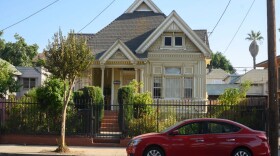We’re dependent on our cars because of freeways and the decisions made around building them. Now imagine a future where we don’t need to drive our cars every day. What would it take to decommission a freeway in San Diego? That is the premise explored in a new podcast by KPBS called “Freeway Exit.” The first two episodes of the six-part series are available May 9, followed by a new episode dropping each week through June 6.
Created and hosted by KPBS metro reporter Andrew Bowen, “Freeway Exit” tells the forgotten history of San Diego’s urban freeway network, and how the building of that network divided communities and created inequities that still exist today. The series also shows how freeway culture has contributed to the climate catastrophe we’re now facing, and how reimagining our freeways could be a key part of the solution.
“There's no denying freeways create a lot of economic opportunity for a lot of people. But despite what their name suggests, freeways are not free. They have hidden costs that aren't shared equally by everyone,” says Bowen.
Transportation accounts for about 55% of San Diego's carbon footprint. Yet the city's Climate Action Plan requires it to reduce its greenhouse gas emissions to zero by 2035. Achieving that goal will require huge reductions in freeway travel. “Freeway Exit” is a deep dive into the reality of what it will take to reach our climate goals , and an effort to hold our leaders accountable to their promises around climate action.
“This is by far the most exciting and rewarding work of journalism I've ever produced,” says Bowen. “I hope after listening to ‘Freeway Exit,’ people will see these massive pieces of infrastructure in a new light, and feel empowered to change their own behaviors in ways that better our community and future.”
The trailer and published episodes can be heard here or wherever you get your podcasts, including Apple Podcasts and Google Podcasts. Community events will also take place in the coming weeks and will be added to the “Freeway Exit” webpage.
“Freeway Exit” is the first project produced by the KPBS Digital Fellowship, a new grant-funded program at the public media station. The Digital Fellowship provides an opportunity for KPBS journalists to spend three to four months developing one single story of significance. During the process, each participant will engage in a listening tour to explore community-driven story ideas and engage personally with the community. Participants will be trained on and learn the most up-to-date best practices in areas such as social media, YouTube, and podcasting. Future projects will cover the topics of youth sports-related injuries and homelessness.
Episode Guide:
Episode 1: San Diego's first freeway
5/9/23
Most people never knew San Diego before the freeway network was built. And for most, it's hard to imagine how life might be without it. But a small group of activists, planners, and politicians are trying to reimagine and repurpose these vast, publicly-owned spaces that cut through our neighborhoods and parks and fill them with noise and air pollution. How was SR-163 built through Balboa Park with the blessing of San Diego voters?
Episode 2: A feat of (social) engineering
5/9/23
There's no historical figure more associated with the freeway than President Dwight D. Eisenhower. As president, Eisenhower championed the National Interstate and Defense Highways Act, which obligated the federal government to fund 90% of a freeway's construction costs. Those subsidies made people like Jacob Dekema, San Diego's longest-serving Caltrans district director, very powerful. But the optimism of the 1950s and 60s blinded freeway proponents to their hidden costs: congestion, noise, pollution, sprawl and division.
Episode 3: The freeway revolts
5/16/23
The "freeway revolts" were a series of protests against urban freeways that took place across the United States in the mid-20th Century. More and more people began to see freeways as nuisances that divided and polluted communities, many of them predominantly Black and Latino. San Diego saw several of these protests, including against SR-163 and Highway 252, which would have connected I-5 with I-805 through the Southcrest neighborhood.
Episode 4: Reparations
5/23/23
There's a growing acknowledgement that the construction of freeways through urban areas did a lot of unjust harm to people, in large part due to their race and socioeconomic status. One of the clearest examples in San Diego is I-5, which did lasting damage to communities like Barrio Logan and National City, and SR-15, which split City Heights down the middle. Can those wounds ever be healed? And what would that healing take?
Episode 5: Decommission
5/30/23
There are not one but two examples of freeways being removed in San Francisco: The Embarcadero Freeway was heavily damaged in the 1989 Loma Prieta earthquake, and rather than spend billions to repair it, the city decided to tear it down and replace it with a boulevard that prioritizes biking, walking and public transit. The same happened on Octavia Boulevard, which replaced a portion of the city's Central Freeway that was also damaged in the earthquake. What can other cities learn from these two successful freeway removal projects?
Episode 6: The road ahead
6/6/23
Both the city of San Diego and the state of California have goals of achieving carbon neutrality, largely by reducing car travel. Yet state, regional and city leaders are still pursuing plans to widen freeways, which will only put more cars on the road. This closing episode will look at what ideas around freeways are being contemplated in San Diego, including a freeway removal that already won unanimous approval from the mayor and City Council but has since been stuck in limbo.
For more information:
Heather Milne Barger
Director of Communications and Marketing
hmilne@kpbs.org




